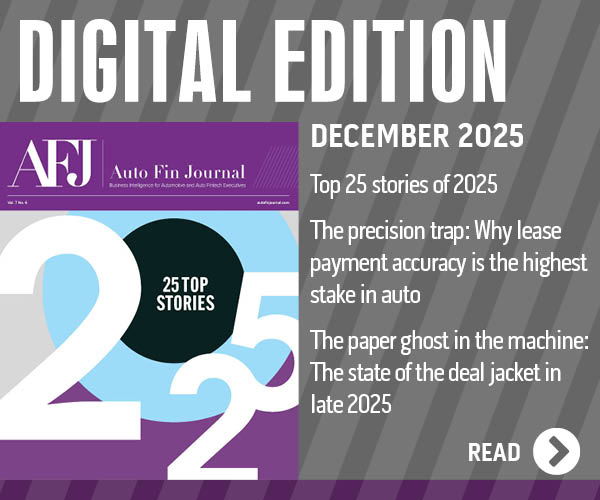COMMENTARY: Strength & resiliency — The rebound of new-vehicle financing

By subscribing, you agree to receive communications from Auto Remarketing and our partners in accordance with our Privacy Policy. We may share your information with select partners and sponsors who may contact you about their products and services. You may unsubscribe at any time.
SCHAUMBURG, Ill. –
Factory shutdowns. Stay-at-home orders. A microchip shortage. Those are just a few of the events that occurred in what’s been nothing short of a challenging year and a half for the automotive industry, particularly in regard to new vehicle financing. Inventory shortages and the economic fallout during the early months of the pandemic drove new vehicle loan originations down, bottoming out last year at 38.05% of total financing in Q2 2020.
Many industry pundits were unsure of the long-term effects of the pandemic, however, the industry proved resilient. With fewer car buyers in the market for a new vehicle a year ago, captive finance companies offered manufacturer incentives and other low-interest rate deals to bring consumers back into the showroom. Now, more than a year later and despite new car incentives being fewer and far between, the new vehicle finance market has rebounded.
According to Experian’s Q2 2021 State of the Automotive Finance Market, new vehicle originations made up nearly 45 percent of total vehicle financing during the quarter, compared to just over 38 percent a year ago. Some of the increase can be attributed to the anomaly that was 2020, however, it’s worth noting that new vehicle originations only made up 40.34% of total financing in Q2 2019.
What’s driving the change?
Despite the percentage of new vehicle originations growing, used vehicles still make up the overwhelming majority of vehicle transactions. However, we are seeing more prime and super prime borrowers opting for new vehicle financing. Findings from our report show that in Q2 2021, 60.45% of prime borrowers and 43.61% of super prime borrowers elected to finance a used vehicle, down from 63.38% and 46.87% a year ago, respectively.
While the automotive market has proved to be fluid over the past year, we can’t lose sight of the impact that new and used vehicle inventory shortages have had on used vehicle prices and values. Although the average MSRP for a used vehicle is still well below that of a new vehicle, with many vehicle owners seeing a higher return on their trade-ins, some could be transitioning back into the new vehicle market.
The state of new-vehicle financing
Despite the ups and downs of 2020 and the first half of 2021, new vehicle financing has returned closer to pre-pandemic levels. For example, based on our findings, the average loan amount for a new vehicle actually decreased to $35,163, down $958 from a year ago—the average loan amount for a new vehicle peaked in Q2 2020 mostly due to the increase in full-size pickup trucks. Additionally, the average loan term dropped to 69.36 months, down from 71.31 months a year ago, and much closer to the 68.84-month mark two years ago. On the flip side, the average loan rate for a new vehicle increased slightly to 4.09%, however is still well-below the 5.70% in Q2 2019.
Subscribe to Auto Remarketing to stay informed and stay ahead.
By subscribing, you agree to receive communications from Auto Remarketing and our partners in accordance with our Privacy Policy. We may share your information with select partners and sponsors who may contact you about their products and services. You may unsubscribe at any time.
Although the average loan amount for a new vehicle decreased nearly $1000 in Q2 2021, it’s still well above $32,345 in Q2 2019; and that’s partly due to the continued infatuation Americans are having with SUVs and CUVs. In Q2 2021, SUVs and CUVs made up 57.54% of newly financed vehicles, up from 53.61% a year ago and a 45% increase from 2016.
Helping prospective shoppers find the right financing
The market is still somewhat in uncharted territory, navigating the microchip shortage and subsequent inventory fallout. Adapting to the fluidity of the environment will require lenders and dealers to closely monitor trends and understand car buyers’ financial situations to find the most advantageous loan terms for the consumer and continue selling cars. One way to do that is to leverage expanded FCRA-regulated data sources, such as rental, utility, telecom and streaming service payments into their lending decisions. These additional data attributes can create a more accurate picture of a car buyer’s financial situation, particularly those with limited-to-no credit history, and more importantly, help lenders approve more auto loans to consumers with affordable payment terms without taking on additional risk.
While new-vehicle financing has recently rebounded, how long the inventory shortage continues to impact the market remains unclear. That said, some industry experts believe low inventories will continue to impact the market for the foreseeable future. That means, used vehicle values could remain high and continue to influence new and used vehicle purchasing decisions. Staying on top of these trends will better position lenders and dealers to make sound business decisions and hopefully continue to prove the automotive industry’s resilience.
Melinda Zabritski is Experian’s senior director of automotive financial solutions.


